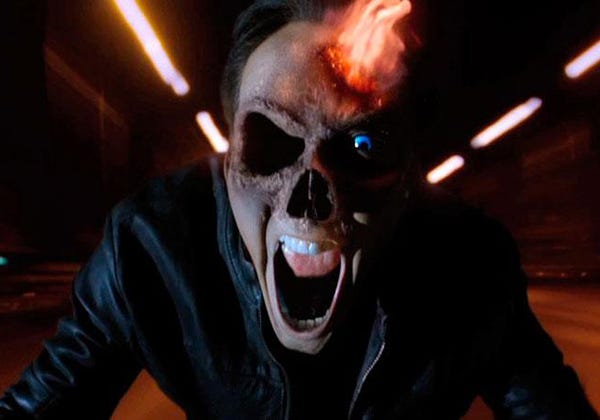Ghost Rider: Spirit of Vengeance

There’s a terrific reminder halfway through “Ghost Rider: Spirit of Vengeance” of why the merits of Nicolas Cage — as horrible as many of his recent movies have been — should never, ever be tossed aside.
What seems like a straightforward stiff-arm to get information from a bad guy turns into full-on gyrational goofiness and laughter that is as much “horse” as it is hoarse.
This is nothing new, mind you. Cage often relies more on support from his eyebrows, lips, gums, nostrils, cheekbones, larynx and forehead than from actors with whom he shares a scene. And he’s got an uncanny ability to find character motivation in punctuation — breathing life into every ellipses or exclamation point.
The difference in this moment, and the rest of the movie, is that Cage gives a damn this time. He’s not amping it up to compensate for a sluggish story or merely making a movie to pay a tax bill; he’s feeding a film some wild juju in wicked, wowzer ways.
Cage seems on the verge of speaking in tongues, babbling that his human form of Johnny Blaze is all that keeps the demonic Ghost Rider from coming forth for vengeance.
“And he’s … SCRAPIN’ AT THE DOOR!!! SCRAPIN’ AT THE DOOR!!!!!” Cage shouts. It’s a crazed crescendo hearkening back to Castor Troy in “Face/Off” — and the year (1997) when that film and “Con Air” generally gave birth to the Cage we now know.
For most folks, it’s also probably the stay-or-bail moment in “Ghost Rider: Spirit of Vengeance” — a wild-hair sequel to a middling Marvel movie that made nearly $300 million worldwide but which most people likely don’t even remember watching.
Tamer but just as weird as previous films from directorial duo Neveldine/Taylor (the “Crank” films, “Gamer”), “Spirit of Vengeance” clearly has a second-tier budget for this second go-round. Bouncing from one Romanian rockpile to another, the film has virtually indistinguishable sets, and it seems like Cage and his co-stars just walk around in cave systems for about 20 straight minutes.
But that matters little in the presence of so many neanderthal-delight moments. The Rider levitates for no apparent reason. Cage shouts, “Merry Christmas, you asshole!” to what is presumably God and also makes reference to “the devil’s baby mama.” There are two fantasy sequences in which a character imagines the Rider pissing fire.
And if it wasn’t yet clear that its demented B-movie ambition trumps its dollar limitations, take the characters in its climactic battle: a soul-hungry demon with a flaming skull head in one corner and a dreadlocked albino zombie decaying what he touches in the other.
Cage plays the former of those two combatants. In recaps, we see a young Johnny strike a deal with the devil to save his father … and, in return, become cursed to change into the Ghost Rider when in the presence of evil. And that’s any evil, even an illegal download. (That’s just part of some pricelessly placid narration from Cage.)
Now in exile, Johnny is somehow the only one who can deliver to safety Danny (Fergus Riordan), a human child pursued by unholy forces and tentatively protected by his mother, Nadya (Violante Placido).
At least that’s what Moreau (Idris Elba), a rough-around-the-edges angelic emissary, thinks. And he entices Johnny with an offer to restore his soul if he saves the child.
An aside: Elba’s accent rotates as often as a truck-stop lunch special; there’s a scene when he seems to simultaneously shout in French, Italian, Creole and Haitian dialects. But after this and “Thor,” how long is he going to be Marvel’s waterboy before he gets to make the Luke Cage movie?
Anyway, Johnny takes the mission, which pits him against a trigger-happy criminal named Carrigan (Johnny Whitworth), gun-toting, wine-drinking monks (led by Christopher Lambert of “Highlander” fame) and Old Scratch himself (Ciaran Hinds).
For all the digital fire on display, one of the best effects is Hinds’ face — which starts to resemble, of all people, Victor Wong’s Egg Shen in “Big Trouble in Little China.” Locked in a palsy freeze, that face gradually seems to fold in on itself — growing increasingly mottled and soft like a rotting peach.
Although “Spirit of Vengeance” lacks Neveldine/Taylor’s usual self-operated, womb-kicking cinematography, it maintains an admirably anarchic dumb-fun sense of humor. Plus, there are two genuinely good action sequences — the Rider turning a crane into a fiery sword and a climactic road chase. True to the source, these compositions resemble comic-book panels in which you can almost see motion lines materialize.
But it mostly comes down to how effectively Neveldine/Taylor ride Cage’s spasmodic reverie. As in “Kick/Ass” and “Bad Lieutenant: Port of Call — New Orleans,” there’s an elation to his exaggerations. It’s not just a way Cage makes something awfully entertaining out of an immediately disposable movie like this. It's a reason to not give up on him.


